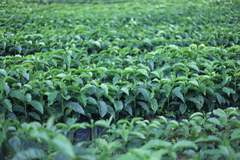New Release: Bolivia
The fresh crop Bolivia has arrived to the roastery and we're now releasing our first few coffees - one from Gerardo Escobars farm and two small lots from Rodriguez own farms Alasitas and La Linda; one Geisha and one Java. Below is some general information about coffee production on Bolivia and an introduction of our producer called Sicafe belonging to Pedro Rodriguez and his daughter Daniela and son Pedro-Pablo.
I have to start by saying that I have fallen in love with Bolivia, the people, the country and their coffee. Bolivia’s high altitude (the coffee growing altitude in Caranavi is 1500-2200 mail in Caranavi), the breath-taking nature, the coffee history, and the quality of the cup with its clear taste profile makes it a very special place. Bolivia’s past is interesting—although it’s a commercially viable coffee exporting country, its production has always been small. The conditions, although challenging, are exceptional for growing coffee, and this produces a very rich agriculture built on a long history of farming on a very difficult and difficult terrain. In 1991, there was a government led initiative to encourage the endogenous population to participate in coffee farming, which led to a fractured system counterintuitive to quality. The arrival of the Cup of Excellence Program in 2004 allowed buyers to find the quality coffee for which Bolivia was already known, but that had become difficult to source.
The main problem for producers was (and, to some extent, still is) that they are unable to make enough money to be sustainable. To subsidise their income, they looked to other crops, mainly coca (the crop that is used to produce cocaine, legal in Bolivia). Encouraged by the government, coca is four times more profitable and is much easier to grow than coffee, and this sadly led to coffee producers turning their back on coffee or, even worse, abandoning their farms. Coca farming involves a lot of chemicals and fertilisers that are not good to the soil and land, so farming cocaleads to the soil being infertile and overworked. Over time, coca-farmed land is unusable for any crop. Bolivian governmental support for growing coca has led to a break-down of relations with the USA, who had previously supported Bolivian agriculture and economy in the early 2000s. The resulting war on drugs in Bolivia has since led to many initiatives to help coffee farmers, with things like the Cup of Excellence being financially supported by USAID.
As if these difficulties weren’t enough to overcome, the arrival of leaf rust in 2013 (a fungus that attacks the leaves of a coffee tree and makes it impossible photosynthesise) meant that the country lost over 50% of its production that year alone. The combination of both government policy and leaf rust means that Bolivia’s coffee production has dropped by over 70% in the past ten years, leaving the county a minor player in the world of coffee.
This means that to find the very best coffees from Bolivia, we have to pay a higher compared to other coffee producing countries—but this isn’t a bad thing. The small volumes available and current demand for great coffees mean that, for once, coffee producers are on the front foot.
The taste profile excites me, with high sweetness and delicious chocolate notes coming together in a very special cup. To showcase how good Bolivian coffee can taste, the Rodriguez family has planted different varietals such as Geisha and Java.

The Rodriguez family own their own mills, processing and exporting coffee for farmers in the Caranarvi and Sud Yungas region. The family have been sourcing coffee from small coffee producers for three decades, but the steady decline of coffee production has put the sustainability of their export business in jeopardy. Without the intervention of people like the Rodriguez family, however, the future of coffee production in Bolivia is at risk of disappearing.

Pedro Rodriguez
The family have taken on the challenge of increasing the production of Bolivian coffee by planting their own new coffee plantations.
In 2014, the Rodriguez family bought a big amount of land in Caranavi region to showcase their practises and educate other producers in sustainable farming, as well as increasing the overall volume at their mills.

Rodriguez new planted farm, La Linda.
Added to this, they have also introduced a sustainable model for the producers who supply them at their mill, and built this on three mantras: economical sustainability, social understanding, and environmental awareness - Sol de Manana.
Caranavi, located 150 kilometres north of La Paz city, it is seen as the centre of Bolivian specialty coffee production. With the super rich soil, combined with high altitudes, for me it is the epicentre for coffee production in Bolivia.
We’re very proud to present this Bolivian coffee to you all, for the impact it will have on the livelihoods to the farmers we're working and the future of Bolivian specialty coffee, but also for the sugary, clear taste profile.
Below are the coffees we're buying from Rodriguez this year. You will be able to read more about the coffees in the webshop as the coffees are being released.
20 x 60kg Nicolas and Maruja Calque - last year under the name Collasuyo
15 x 60kg Alasita, Caturra, Lot Mirador
1 x 60kg Alasita, Geisha
1 x 60kg La Linda, Java
Learn More
- Choosing a selection results in a full page refresh.
- Press the space key then arrow keys to make a selection.
